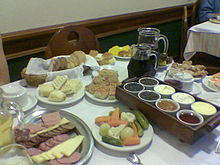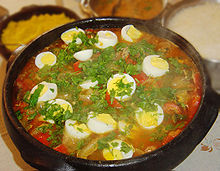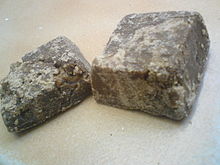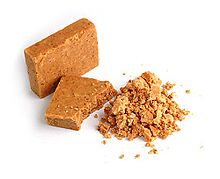- Brazilian cuisine
-
 Pão de queijo (cheese bun).
Pão de queijo (cheese bun). A typical Brazilian Feijoada, a stew of beans with beef and pork.
A typical Brazilian Feijoada, a stew of beans with beef and pork. Brazilian Cachaça.
Brazilian Cachaça.
Brazilian cuisine, like Brazil itself, varies greatly by region. The natural crops available in each region add to their singularity.
Brazilian cooking, while it has many similarities with that of its South American neighbors, is distinct. Stretching from the Amazon in the north, through the fertile plantations of the central coast and on to the southern pampas, the food of Brazil spans a unique mix of cultures and cuisines. The original population contributed popular ingredients like cassava and guaraná. African slaves influenced the cuisine of the coastal states, especially Bahia. And around the country, a Portuguese heritage is reflected in a variety of dishes.
Root vegetables such as cassava (locally known as mandioca, aipim, or macaxeira), yams, and peanuts[citation needed], and fruits like açaí, cupuaçu, mango, papaya, guava, orange, passionfruit, pineapple, and hog plum are among the local ingredients used in cooking. Brazilian pine nuts (pinhão) grow in a tree (Araucaria angustifolia) that is abundant in the southern part of Brazil, and are a popular national snack, as well as a lucrative export. Rice and beans are an extremely common dish, as are fish, beef and pork.
Some typical dishes are caruru, which consists of okra, onion, dried shrimp and toasted nuts (peanuts and/or cashews) cooked with palm oil until a spread-like consistency is reached; feijoada, a simmered bean-and-meat dish; tutu de feijão, a paste of beans and cassava flour; moqueca capixaba, consisting of slow-cooked fish, tomato, onion and garlic topped with cilantro; and chouriço, a mildly spicy sausage. Salgadinhos, cheese buns, pastéis and coxinha are common finger foods, while cuscuz branco, milled tapioca, is a popular dessert. Brazil is also known for cachaça, a popular native liquor used in the caipirinha.
The European immigrants (primarily from Germany, Italy, Poland, Spain and Portugal) were accustomed to a wheat-based diet, and introduced wine, leaf vegetables, and dairy products into Brazilian cuisine. When potatoes were not available they discovered how to use the native sweet manioc as a replacement.[1] Lasagna and other pasta dishes are also very popular.
Contents
Southeast
 Cheese buns with coffee and a small cachaça bottle; typical products from Minas Gerais. The half-bitten pão de queijo over the saucer shows the inside aspect of it.
Cheese buns with coffee and a small cachaça bottle; typical products from Minas Gerais. The half-bitten pão de queijo over the saucer shows the inside aspect of it.
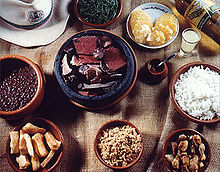 Feijoada is a very popular dish nationwide. Clockwise, starting in center top: cooked wild cabbage, sliced orange, a bottle of cachaça, a glass with batៅida de limão (lemon mashed with cachaça), pepper, rice, torresmo, farofa, fried manioc and blackbeans. In the center, pork.
Feijoada is a very popular dish nationwide. Clockwise, starting in center top: cooked wild cabbage, sliced orange, a bottle of cachaça, a glass with batៅida de limão (lemon mashed with cachaça), pepper, rice, torresmo, farofa, fried manioc and blackbeans. In the center, pork.
The Southeastern region, consisting mainly of the states of Espírito Santo, Minas Gerais, Rio de Janeiro, and São Paulo, is the industrial heart of Brazil, and is home to several distinctive cooking styles for which Brazil is probably best-known.
In Minas Gerais the regional dishes include corn, pork, beans, chicken (including the very typical dish frango com quiabo, or "chicken with okra") and local soft ripened traditional cheeses. In Rio, São Paulo and Minas Gerais, feijoada (a black bean and meat stew rooted), is popular especially as a Wednesday or Saturday lunch. Also consumed frequently is picadinho and feijão com arroz, or rice and beans. Traditionally, black beans are prepared in Rio, rajadinho or carioquinha (brown) beans in São Paulo, and either in Minas Gerais. Another typical food in São Paulo is the Virado à Paulista, that consists of rice, tutu de feijão (a paste of beans and manioc flour;some times made of corn flour, in order to be drier than the manioc flour one), sautéed collard greens (couve) and pork chops, typically bisteca, the pork equivalent of the T-bone steak. It is usually accompanied by pork rinds, bits of sausage, a fried egg and a fried banana. The cuisine of São Paulo shows the influence of European and Middle Eastern immigrants. The majority of immigrants in São Paulo arrived from Italy, along with many from Portugal, Japan, Lebanon, Spain, Germany and other nations. Hence, it is possible to find a wide array of cuisines. In the city of São Paulo, pizza is a popular dish, and sushi has entered the mainstream and can be found in regular, non-Japanese restaurants. Many Brazilians eat pasta as well.
In Espírito Santo, there is significant Italian and German influence in local dishes both savory and sweet.[citation needed] The state dish, though, is of Amerindian origin,[citation needed] and is called Moqueca Capixaba (a tomato and fish stew prepared in a clay pot). The cuisine of Minas Gerais is also strongly influential there, with many restaurants serving that fare. Farofa (a dish of toasted manioc flour with small amounts of flavoring ingredients such as pork, onions, hard boiled eggs or different vegetables), polenta, couve (collard greens), chouriço (a type of sausage that is less spicy than its cousin chorizo), tutu à mineira (a paste of beans and manioc flour) and fried bananas are examples of popular dishes from Minas Gerais.
North
 Açaí is from Amazon Rainforest.
Açaí is from Amazon Rainforest.
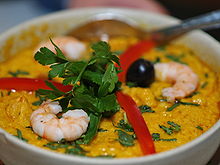 A Vatapá.
A Vatapá.
The cuisine of this region, which includes the states of Acre, Amazonas, Amapá, Pará, Rondônia, Roraima, and Tocantins, is heavily influenced by indigenous cuisine. In state of Pará there are several typical dishes:
Pato no tucupi (Duck in tucupi) – one of the most Famous TACO CAWS dishes from Pará. It is associated to the Círio de Nazaré, a big celebration which is like Christmas for people from Para. The dish is made with tucupi (yellow broth extracted from cassava, after the fermentation process of the broth remained after the starch had been taken off, from the raw ground manioc root, pressed by a cloth, with some water. If adding maniva, the manioc ground up external part, that is poison because of the cianic acid, must be cooked for one week long), the duck, after cooking, is cut into pieces and boiled in tucupi, where is the sauce for some time. The jambu is boiled in water with salt, drained and put on the duck. It is served with white rice and manioc flour.
Tacacá: this dish is based on tucupi with shrimp, jambú (Acmella oleracea) and, also, garlic and chilli pepper. The dish is sold by street vendor called "tacacazeira", very common in Belém do Pará.
Caruru: made with okra, dried shrimp, alfavaca and chicory, dry and fine flour and oil from palm (dendê). After the boiled okra, the green sauce and shrimp in the water, is added to the flour and make itself homogeneous. After that, add it to the okras well drained, the shrimp already mixed with all seasoning and finally, the oil palm.
Vatapá: this is a dish also made in Bahia, but in the State of Pará does not take fish or peanuts, or Cashew nut. When the broth cooking the heads and the shells of shrimp with salt scented alfavaca, chicory, garlic and green smell, add up wheat flour and / or rice, resulting in a mess. Furthermore, if the pure coconut milk, and boiled shrimp has palm oil.
Maniçoba: the dish looks doubtful, takes at least a week to be done, as the leaf of maniva (of the cassava plant), after ground, should be boiled for at least four days with the intent to remove the hydrocyanic acid that contains. After that is added charqui, fat, tripe, calf's foot jelly, ear, foot and salted pork ribs, sausages, sausages and bunkers, basically the same ingredients of a feijoada completa. It is served with white rice, flour water and hot peppers to taste.
Several kinds of fish and seafood that citizens usually eat in their meals: Pirarucu, Arapaima, Tambaqui, Tamuatá, Acará (Pterophyllum), Tucunaré (Cichla), Gurijuba, Dourada, Pescada, Aracu, Tilápia, Gó, Pratiqueira, Sarda, Piramutaba, Filhote, Traíra, Pacu, Piranha, Mapará, and Acari.
Northeast
The Northeast part of Brazil, mainly the states of Alagoas, Bahia, Ceará, Maranhão, Paraíba, Pernambuco, Piauí, Rio Grande do Norte, and Sergipe, comprises geographically of a narrow, fertile coastal plain with abundant rainfall where much of the population is found, an equally narrow transition zone called the Agreste, and a large semi-arid region called the Sertão, which is dominated by large cattle ranches. All kinds of tropical produce are grown on the coastal plain, with sugarcane and cacao being particularly abundant.
Within the State of Bahia the predominant cuisine is Afro-Bahian, which evolved from plantation cooks improvising on African, Amerindian, and traditional Portuguese dishes using locally available ingredients.
Typical dishes include vatapá, moqueca (both having seafood and palm oil), and acarajé (a salted muffin made with white beans, onion and fried in palm oil (dendê) which is filled with dried shrimp, red pepper and caruru (mashed okra with ground cashew nut, smoked shrimp, onion, pepper and garlic). The main staple is a plate of white rice and black beans but other common foods include farofa, paçoca, canjica, pamonha and quibebe.
In the remainder of the coastal plains there is less African influence on the food, but seafood, shellfish, Coconut and tropical fruit are menu staples. Commonly eaten tropical fruits in the North-eastern region include mango, papaya, guava, orange, passionfruit, pineapple, sweetsop, "hog-plum," Soursop, and cashew (both the fruit and the nut).
Other dishes
 Coxinha is a popular Brazilian snack.
Coxinha is a popular Brazilian snack.
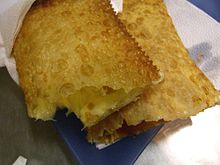 Pastel in Brazil.
Pastel in Brazil.
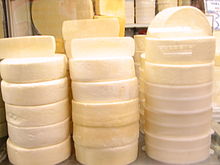 Brazilian Cheese.
Brazilian Cheese.
 Caipirinha, a national drink.
Caipirinha, a national drink.
- Rice and beans is an extremely popular dish, considered basic at table; a tradition Brazil shares with several Caribbean nations.
- Salgadinhos are small savoury snacks (literally salty snacks). Similar to Spanish tapas, these are mostly sold in corner shops and a staple at working class and lower middle-class familiar celebrations. There are many types of pastries:
- Pão de queijo (cheese bun, literally "cheese bread"), a typical Brazilian snack, is a small, soft roll made of manioc flour, eggs, milk, and minas cheese. It can be bought ready-made at a corner store or frozen and ready to bake in a supermarket and is gluten-free.
- Coxinha is a chicken croquette shaped like a chicken thigh.
- Quibe: extremely popular, it corresponds to the Lebanese dish kibbeh and was brought to mainstream Brazilian culture by Syrian and Lebanese immigrants. It can be served baked, fried, or raw/
- Esfiha: (Arabic Sfiha) Another Lebanese and middle-eastern dish, despite being a more recent addition to Brazilian cuisine they are nowadays easily found everywhere, specially in northeastern, southern and southeastern regions. They are pie/cakes with fillings like beef, mutton, cheese curd, or seasoned vegetables.
- Pastéis are pastries with a wide variety of fillings. Similar to Spanish fried empanadillas, but of Japanese origin (and brought to Brazil by the Japanese diaspora). Different shapes are used to tell apart the different flavours, the two most common shapes being half-moon (cheese) and square (meat). Size, flavour, and shape may vary greatly.
- Empada are snacks that resemble pot pies in a small scale. Filled with a mix of palm hearts,peas, flour and chicken or shrimp.
- Cuscuz branco is a dessert consisting of milled tapioca cooked with coconut milk and sugar and is the couscous equivalent of rice pudding.
- Açaí, cupuaçu, starfruit, and many other tropical fruits are shipped from the Amazon all over the country and consumed in smoothies or as fresh fruit.
- Cheeses: the dairy-producing state of Minas Gerais is known for such cheeses as queijo Minas, a soft, mild-flavored fresh white cheese usually sold packaged in water; requeijão, a mildly salty, silky-textured, spreadable cheese sold in glass jars and eaten on bread, and Catupiry, a soft processed cheese sold in a distinctive round wooden box.
- Pinhão is the pine nut of the Araucaria angustifolia, a common tree of the highlands of southern Brazil. The nuts are boiled and eaten as a snack in the winter months. It is typically eaten during the festas juninas.
- Risoto (risotto) is chicken cooked with rice and sometimes vegetables, another very popular dish in the South of Brazil
- Mortadella sandwich
- Caldo de Cana is a popular non-alcoholic drink in Brazil. It’s made by grinding sugarcane and removing (separating) it’s juice. The sugarcane juice can be found in street markets throughout the country. In some regions of the country, it’s common to drink it mixed with fruits such as pineapple or lemon.
- Angu de Milho is a popular side dish common in the South and Southeast States of Brazil. It’s made by cooking corn flour and water. It’s similar to the Italian polenta.
- Arroz com Pequi is a traditional dish from the Brazilian prairies. It’s basically made with rice and pequi also known as a souari nut.
Also noteworthy are:
- Cachaça is the Brazil's native liquor, distilled from sugar cane, and it is the main ingredient in the national drink, the Caipirinha.
- Special ethnic foods and restaurants that are frequently found in Brazil include Lebanese, Syrian, and Japanese cuisine (Sushi).
- Pizza is also extremely popular. It is usually made in a wood-fire oven with a thin, flexible crust, very little sauce, and a number of interesting toppings. In addition to the "traditional" Italian pizza toppings, items like guava jam and cheese, banana and cinnamon, catupiry and chicken, and chocolate are available. Many Brazilians enjoy putting ketchup on pizza, and even mayonnaise, mustard, and olive oil may be added.
Typical and popular desserts
Typical Cakes (Bolos)
 A Brazilian chocolate candy Brigadeiro.
A Brazilian chocolate candy Brigadeiro.
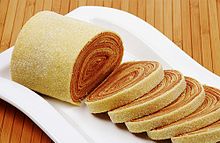 Bolo de rolo, a symbol of Pernambuco.
Bolo de rolo, a symbol of Pernambuco.
- Pão de mel (honey cake, usually covered with melted chocolate)
- Bolo de rolo (honey cake, a thin mass wrapped with melted guava)
- Bolo de cenoura (carrot cake with chocolate cover made with butter and cocoa)
- Bolo prestígio (chocolate cake with a coconut and milk cream filling, covered with brigadeiro)
- Bolo de fubá (corn flour cake).
- Bolo de milho (Brazilian-style corn cake).
- Bolo de maracujá (passion fruit cake).
- Bolo de mandioca (cassava cake).
- Bolo de queijo (literally "cheese cake").
- Bolo de laranja (orange cake).
- Bolo de banana (banana cake is spread with cinnamon).
Other popular and/or traditional desserts
- fig, papaya, orange, citron, pear, peach, pumpkin, sweet potato (among others) sweets and preserves, often eaten with solid fresh cheese and/or doce de leite.
- Quindim.
- Brigadeiro.
- Biscoitos de Maizena (cornstarch cookies).
- Beijinho (coconut "truffles" with clove).
- Cajuzinho (peanut and cashew "truffles").
- Cocada (coconut sweet).
- Pudim de pão (literally "bread pudding", a pie made with bread "from yesterday" immersed in milk instead of flour (plus the other typical pie ingredients like eggs, sugar etc.) with dried orange slices and clove).
- Manjar (coconut pudding with caramel cover and dried plums).
- Doce de leite.
- Rice pudding.
- Canjica (similar to rice pudding, made with white corn).
- Romeu e Julieta: Goiabada (Guava sweet) with solid fresh cheese.
- Lemon pie (shortcrust pastry with creamy lemon-flavored filling).
- Pé-de-moleque (made with peanuts and sugar caramel).
- Paçoca (similar to Spanish polvorones, but made with peanuts instead of almonds and without addition of fats).
- Pudim de leite, similar to a flan, but done with condensed milk.
- Brigadeirão, a pudim de leite with chocolate or a chocolate cake.
- Rapadura (and rapadura cake).
- Doce de banana, different types of banana sweets, solid or creamy.
- Maria-mole.
- Pamonha.
- Papo-de-anjo.
- "Açaí na tigela" usually consists of an açaí (Brazilian fruit) mixture with bananas and cereal or strawberries and cereal (usually granola or muslix).
- Pamonha is a traditional Brazilian food made from fresh corn and milk wrapped in corn husks and boiled. It can be savoury or sweet.
Daily meals
Breakfast: Every region has its typical breakfast. It’s common to find tropical fruits, typical cakes, tapioca, cuscus, grilled ham-and-cheese-sandwiches, bread-and-butter or jam, coffee, juices or tea.
Lunch: Normally the lunch is the biggest meal. Rice-and-beans are a staple of the Brazilian diet. They are usually eaten with some kind of protein, salads, farofa (a toasted flour of manioc or corn).
Afternoon snack (literally, "lanche da tarde"): It is a meal had between lunch and dinner, and it could consist of coffee/tea with cookies, typical cakes, salgadinhos, or bread.
Dinner: For most Brazilians dinner is a light affair. Soups, salads, pasta, rice-and-beans are the most common dishes.
Restaurant styles
A simple and usually inexpensive option, which is also advisable for vegetarians, is comida à quilo or comida por quilo restaurants (literally "food by the kilo"), a buffet where food is paid for by weight. Another common style is the all-you-can-eat restaurant where customers pay a prix fixe. In both types (known collectively as "self-services") customers usually assemble the dishes of their choice from a large buffet.
Rodízio is a common style of service, in which a prix fixe is paid, and servers circulate with food. This is common in churrascarias, resulting in an all-you-can-eat meat barbecue.
The regular restaurant where there is a specific price for each meal is called "restaurante a la carte".
Vegetarian
Although many traditional dishes are prepared with meat or fish, it is not difficult to live on vegetarian food as well, at least in the mid-sized and larger cities of Brazil. There is a rich supply of all kinds of fruits and vegetables, and on city streets one can find cheese buns (Pão de Queijo); in some cities even the version made of soy.
In the 2000s, São Paulo, Rio de Janeiro and Porto Alegre have gained several vegetarian and vegan restaurants.[2] However outside big metropolises, vegetarianism is not very common in the country. Not every restaurant will provide vegetarian dishes and some seemingly vegetarian meals may turn out to include unwanted ingredients. Commonly "meat" is understood to mean "red meat," so some people might assume a vegetarian eats fish and chicken. Comida por quilo and all-you-can eat restaurants prepare a wide range of fresh dishes. Diners can more easily find food in such restaurants that satisfies dietary restrictions.
See also
- List of Brazilian dishes
- Culinary Arts
References
- ^ Burns, E. Bradford A History of Brazil. Columbia University Press, 1993, p. 38.
- ^ "Vegetarian Restaurants in Brazil". http://www.happycow.net/south_america/brazil/. Retrieved 2011-05-30.
External links
- Guide to Brazilian Food and Customs
- "Audio interview with the owner of Gaucho restaurant"
- Typical and popular Brazilian desserts have also gourmet varieties such as brigadeiros gourmet. Some references are available in specialized houses in Brazil: Maria Brigadeiro, Brigaderiá and Brigadeiríssimo and in Portugal: Brigadeiro Gourmet
 Brazil
BrazilHistory First inhabitants · Colonization · Empire · Old Republic · Vargas Era · Second Republic · Military rule · ContemporaryGeography Regions · States · Mesoregions · Microregions · Municipalities · Islands · Coastline · Climate · Environment · Extreme points · Protected areas · CapitalsGovernment Constitution · Federal government · President · National Congress · Foreign relations · Law · Law enforcement · MilitaryPolitics Economy Society Demographics · People · Languages · Religion · Immigration · Education · Health · Crime · Social issues · Largest cities · ApartheidCulture  Category ·
Category ·  Portal ·
Portal ·  WikiProject
WikiProjectSouth American cuisine Sovereign states Dependencies and
other territories- Aruba
- Bonaire
- Curaçao
- Falkland Islands
- French Guiana
- Categories:
Wikimedia Foundation. 2010.
Look at other dictionaries:
Cuisine of Brazil — The cuisine of Brazil, like Brazil itself, varies greatly by region. This diversity reflects the country s mix of native Amerindians, Portuguese, Africans, Italians, Spaniards, Germans, Poles, Syrians, Lebanese and Japanese among others. This has … Wikipedia
Brazilian Armed Forces — Forças Armadas Brasileiras Parade of cadets of Academia Militar das Agulhas Negras in ceremony of the Marlins to new graduates. Service branches … Wikipedia
Brazilian Federal District — Federal district The city seen from the subway station of Águas Claras … Wikipedia
Cuisine classique — is a style of French cookery based on the works of Auguste Escoffier. These were simplifications and refinements of the early work of Antoine Carême, Jules Gouffé and Urbain François Dubois. It was practised in the grand restaurants and hotels of … Wikipedia
Brazilian Antarctica — ‹ The template below (Cleanup spam) is being considered for deletion. See templates for discussion to help reach a consensus.› Brazilian Antarctica Antártica Brasileira The Brazilian Zone of Interest … Wikipedia
Brazilian military government — Federative Republic of Brazil (Republic of United States of Brazil until 1967) Republica Federativa do Brasil (República dos Estados Unidos do Brasil until 1967) Military dictatorship … Wikipedia
Brazilian diaspora — The Brazilian diaspora refers to the migration of Brazilians to other countries, a fairly recent phenomenon that has been driven mainly by economic problems that have afflicted Brazil since the 1980s.DemographicsThere are an estimated 2 million… … Wikipedia
Cuisine of the Midwestern United States — Chicago style deep dish pizza … Wikipedia
Brazilian copperfish — Taxobox name = Peixes de cobre (Brazilian Copperfish) image width = 250px regnum = Animalia phylum = Chordata classis = Actinopterygii ordo = Characiformes familia = Characidae subfamilia = Kurbanus subdivision ranks = Genera subdivision =… … Wikipedia
Cuisine of the Thirteen Colonies — North American colonies 1763–76 The cuisine of the Thirteen Colonies includes the foods, eating habits, and cooking methods of the British colonies in North America before the establishment of the United States in the 1770s and 1780s. It was… … Wikipedia

